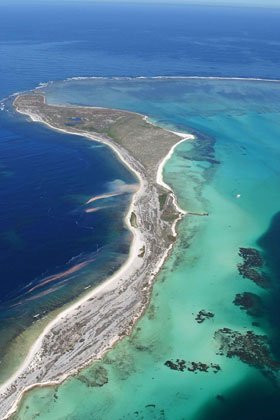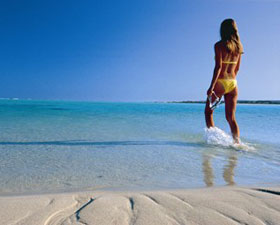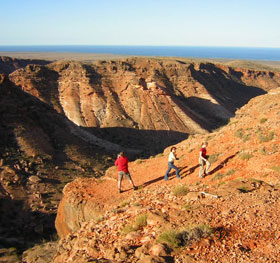 |
 |

Kalbarri: Kalbarri National Park is generally considered one of the best National Parks in Australia in terms of ease of access and variety of natural attractions. The elaborate and spectacular twists and turns of the Murchison River as it cuts its way to the sea through spectacular gorges, the dramatic beauty of Red Bluff, and the equally dramatic sandstone cliffs to the south of Kalbarri township make it a National Park rich in variety, drama and beauty. Between August and October, it becomes a vast carpet of wildflowers.

![]()
Shark Bay: a place of stark seascapes, islands, bays and bays that are habitat for a range of plants and animals found in the wild nowhere else on Earth. A World Heritage Area, Shark Bay has a coastline more than 1,500 km long. Its bays, inlets and islands support a profusion of aquatic life. Turtles, whales, prawns, scallops, sea snakes, fish and sharks are common.
One of only two places in the world with living marine Stromatolites, or "living fossils", Hamelin Pool also has the distinction of being Western Australia's only marine nature reserve.

|

Abrolhos Islands: 64km off the coast of Geraldton, The Abrolhos is surrounded by reefs and shipwrecks. The islands are a bird-watchers paradise and are also the centre of the area's lobster-fishing industry. Access by charter/fishing/eco boat tours are available from Geraldton and Kalbarri. Alternatively, take a flight over the coral reefs and islands that form a stunning abstract of the most incredible range of greens and blues.

![]()
Monkey Mia: The major attraction in the Shark Bay region is without doubt the feeding of wild dolphins at Monkey Mia. In the 1960s, fishermen began feeding bottlenose dolphins in the Shark Bay area, which in time began appearing regularly when they returned with their catch. Over the years, the association continued. News of the phenomenon travelled by word of mouth and visitors now come from far and wide to see the dolphins.

|

Ningaloo Reef: The wonderful thing about Ningaloo Reef, besides the excellent diving, snorkelling and coral viewing opportunities, is the fact that you walk straight off the beach and onto the reef. On this reef, the longest coastal reef in the world, you'll see see fish, whales, dugongs and turtles. From March through June each year the area is visited by migrating whale sharks and humpback whales. The townships of Coral Bay and Exmouth are the major base points for visiting the Ningaloo Reef.


North West Cape: the peninsula which separates Exmouth Gulf from the Indian Ocean on the north west tip of the continent contains the rugged and waterless Cape Range and Rough Range. A locality full of contrasts, the traveller passes from high plateau shrub land to deep ocean, eucalypt woodlands to deep rocky gorges, within just a few kilometres. The scenery is quite breathtaking, from the flat coastal plain to the range's rocky canyons and terraces, coastal dunes, white sand beaches and turquoise water and rocky shores.

|
| Visiting The Region: The Facts |
How to get there: Because of the vast distances between localities, and that many highlights can only be reached by road, serious consideration should be given to touring the area by motor vehicle, or as part of an organised tour, unless you only have the time or inclination to visit a single locality. In such cases, way up carefully the cost and time involved in going to just one locality. Many travellers who have done that feel it did not provide value for money and wished they had made alterative travel arrangements or not gone at all.
By air, Skywest Airlines operate a twice daily service between Perth and Exmouth, Carnarvon, Geraldton, Kalbarri and Shark Bay, and a weekly service (on Sundays) between Broome and Exmouth.
By road, travel north from Perth on Great Northern Highway, taking Brand Highway at Muchea. The Greyhound bus takes approximately twelve hours from Perth to Carnarvon and travels every day, some days twice, to localities throughout the region.
|
The best time to go: June to November are the best times to visit the localities in the north. December to April is cyclone season in the tropical regions and most rainfall occurs at these times. The area to the south of Kalbarri is not affected by cyclones to any great degree, so this region can be visited any time of the year. The summer months can be hot and flies can be a nuisance then, so March to May and August to November are our preference.
June is the season to swim with the Whale Sharks at Ningaloo Reef, as they migrate through these waters at that time. Humpback whales visit the the Coral and Shipwreck Coasts between June to November each year, migrating twice annually through the area into the Exmouth Gulf. The first visit occurs in late autumn (June-July) during their northern migration, and they return in their southern migration each spring (September-November).
Wildflowers occur throughout the Coral Coast region. July to November is wildflower season, with the best bloom around September to November.
|
|

| Regions of Western Australia |
|